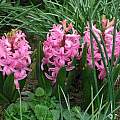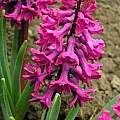Hyacinthus is a genus in the Hyacinthaceae family that has had many taxonomic revisions with various plants moved in and out of it. There are three species left from Turkey to Central Asia. One of them, Hyacinthus orientalis is the parent of the many cultivars that are offered for sale each fall and are often forced.
Hyacinthus orientalis L. is native to the Eastern Mediterranean and is planted in autumn and dried off in summer. Height: about 30 cm.
Hyacinthus orientalis ssp. chionophilus Wendelbo is an alpine subspecies from Turkey. This form has been easy to grow in Northern California, in a pot kept dry in summer. It has not increased so I usually plant it with something else. It usually blooms in March. Photos by Mary Sue Ittner taken different years. The last shows the bulb on a 1 cm grid.
Photos from Rimmer de Vries of plants grown from seed (BATMAN 423) from the Gothenburg Botanic Garden started in 2007 and 2008. Batman is a city in the Southeastern Anatolia Region of Turkey and the capital of Batman Province. It lies on a plateau, 540 meters above sea level, near the confluence of the Batman River and the Tigris.
Hyacinthus orientalis ssp. orientalis is a recognized subspecies with a synonym of Hyacinthus orientalis ssp. albulus. The photo below is of a long lasting heirloom bulb in the Southern USA known as var. albulus that is probably this subspecies. This specimen was collected in Navasota, TX and is self-fertile. Photo by Cynthia W. Mueller.
Photos from Rimmer de Vries of plants grown from seed (BATMAN 014) from the Gothenburg Botanic Garden. Notice the difference in the leaves between the BATMAN collection seed examples of the two sub-species; ssp chinophilus (above) has wider flatter rather glaucous leaves and ssp orientalis has more upright green and canoe shaped leaves.
Here is a similar blue-flowered form which has grown in the Montgomery County, Maryland, USA, zone 7 garden of Jim McKenney for perhaps forty years. It's nothing to look at, but the fragrance is wonderful!
Hyacinthus orientalis cultivars come with single or multiple stems, single or double flowers, and are white to cream, pink, blue to purple and densely to loosely packed. Honeybees and bumblebees like the fragrant single flowered varieties. See a video of honeybees visiting a white form and a blue form by Travis Owen (or see in-line videos below). Photos below taken by Janos Agoston of named cultivars:
'Anna Liza', 2 of 'Anne Marie', 'Fondante', 'Gipsy Queen', 'Jan Bos'
'Multiflora Pink', 'Pink Perfection', 'Splendid Cornelia', 'Woodstock'
2 of 'Carnegie', 'City of Haarlem', 2 of 'Multiflora White', 'Yellow Queen'
'Delft Blue', 2 of 'Ostara'































